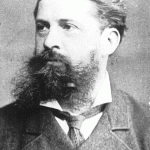 Welcome to our topic on Charles Peirce! Charles Peirce (1839–1914) was the founder of American pragmatism after about 1905 called by Peirce “pragmaticism” in order to differentiate his views from those of William James, John Dewey, and others, which were being labelled “pragmatism.” Practicing geodesy and chemistry in order to earn a living, he nevertheless considered scientific philosophy, and especially logic, to be his true calling, his real vocation. He is best known as the founder of the largely American philosophical school of Pragmatism, which was later popularized by his life-long friend William James and his one-time student John Dewey, although his contributions to the development of modern Logic were also of the first order.
Welcome to our topic on Charles Peirce! Charles Peirce (1839–1914) was the founder of American pragmatism after about 1905 called by Peirce “pragmaticism” in order to differentiate his views from those of William James, John Dewey, and others, which were being labelled “pragmatism.” Practicing geodesy and chemistry in order to earn a living, he nevertheless considered scientific philosophy, and especially logic, to be his true calling, his real vocation. He is best known as the founder of the largely American philosophical school of Pragmatism, which was later popularized by his life-long friend William James and his one-time student John Dewey, although his contributions to the development of modern Logic were also of the first order.
“The pragmatist knows that doubt is an art which has to be acquired with difficulty.” ~ Charles Peirce
Who is Charles Peirce?
Charles Peirce is a theorist of logic, language, communication, and the general theory of signs (which was often called by Peirce “semiotics”), an extraordinarily prolific logician (mathematical and general), and a developer of an evolutionary, psycho-physically monistic metaphysical system. Practicing geodesy and chemistry in order to earn a living, he nevertheless considered scientific philosophy, and especially logic, to be his true calling, his real vocation. In the course of his polymathic researches, he wrote voluminously on an exceedingly wide range of topics, ranging from mathematics, mathematical logic, physics, geodesy, spectroscopy, and astronomy, on the one hand (that of mathematics and the physical sciences), to psychology, anthropology, history, and economics, on the other (that of the humanities and the social sciences).
Key Philosophical Works
- 1870 How To Make Our Ideas Clear
- 1931 The Rule of Reason
The Philosophy of Charles Peirce
Charles Sanders Peirce was the scientist, logician, and philosopher of science who pioneered the philosophical movement known as pragmatism. Deeply sceptical of metaphysical ideas—such as the idea that there is a “real” world beyond the world we experience—he once asked his readers to consider what is wrong with the following theory: a diamond is actually soft, and only becomes hard when it is touched.
Peirce argued that there is “no falsity” in such thinking, for there is no way of disproving it. However, he claimed that the meaning of a concept (such as “diamond” or “hard”) is derived from the object or quality that the concept relates to—and the effects it has on our senses. Whether we think of the diamond as “soft until touched” or “always hard” before our experience, therefore, is irrelevant. Under both theories he diamond feels the same, and can be used in exactly the same way. However, the first theory is far more difficult to work with, and so is of less value to us.
This idea, that the meaning of a concept is the sensory effect of its object, is known as the pragmatic maxim, and it became the founding principle of pragmatism—the belief that the “truth” is the account of reality that works best for us. One of the key things Peirce was trying to accomplish was to show that any debates in science, philosophy, and theology are meaningless. He claimed that they are often debates about words, rather than reality, because they are debates in which no effect on the senses can be specified
Father of Pragmatism
Pragmatism is a philosophy which suggests that human knowledge should be viewed more as an adaptive response to the environment in its ability to solve problems. Peirce also invented Semiotics – the Theory of Signs. This is a study of signs and symbols. He classified signs as natural (clouds signify rain, spots signify measles), iconic (signs signify or symbolize a thing, such as labels of products) or conventional (where the sign is invented as a result of agreement or conventional such as color red for danger, bravery, blood, war, among others). Peirce called the last sign as symbols.
Words and language are constructed out of these symbols. Natural and iconic signs usually signal the presence of that which they refer to. But symbols like words rarely do so. Peirce maintained that words are “arbitrary” symbols which generate meaning and not the meaning themselves.
References
- Dorling Kindersley. (2011). The Philosophy Book. New York: DK Publishing.
- Stumpf, Samuel Enoch. (2008). From Socrates to Sartre and Beyond. New York: McGraw Hill Publishing.
- Palmer, Donald.(2006). Looking at philosophy:The unbearable heaviness of philosophy made lighter 4th Edition. New York: McGraw Hill Companies.
- Gaarder, Jostein. (2004). Sophie’s World. Great Britain: Phoenix House.
- Charles Sanders Peirce. Stanford Encyclopedia of Philosophy. Accessed on September 19, 2017 at https://plato.stanford.edu/entries/peirce/
- Charles Sanders Peirce: Pragmatism. Internet Encyclopedia of Philosophy. Accessed on September 24, 2017 at http://www.iep.utm.edu/peircepr/
- Charles Sanders Peirce: The Basics of Philosophy. Accessed on September 17, 2017 at http://www.philosophybasics.com/philosophers_peirce.html